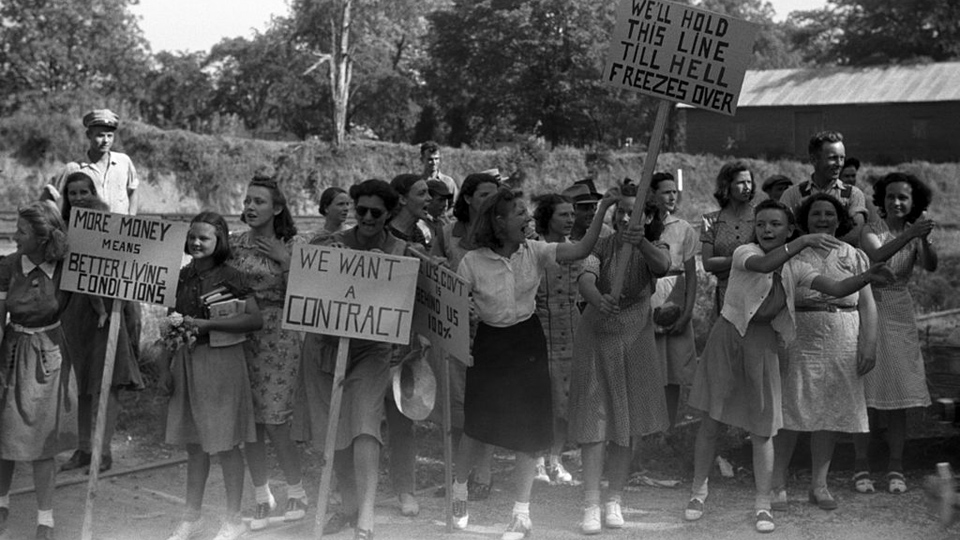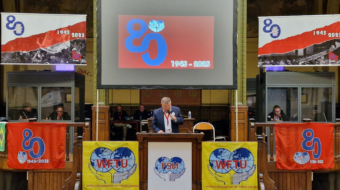
Editor’s note: The following was published Nov. 9, 2015.
The creation of the Congress of Industrial Organizations (CIO) was announced 80 years ago on this day, Nov. 9, 1935, by eight international unions belonging to the American Federation of Labor (AFL).
The CIO was a federation of unions that organized workers in industrial unions in the United States and Canada from 1935 to 1955. Created by John L. Lewis, it was originally called the Committee for Industrial Organization, but changed its name in 1938 when it broke away from the AFL.
The CIO supported Franklin D. Roosevelt and the New Deal Coalition, and was open to African Americans. Its advocacy for industrial unionism echoed the philosophy of the Industrial Workers of the World (IWW), founded in 1905. Both the CIO and the AFL grew rapidly during the Great Depression. The rivalry for dominance was bitter and sometimes violent. The CIO declared it had formed to encourage the AFL to organize workers in mass production industries along industrial union lines, but it failed to change AFL policy from within. On Sept. 10, 1936, the AFL suspended all 10 CIO unions (two more had joined in the previous year). In 1938, these unions formed the Congress of Industrial Organizations as a rival labor federation.
The CIO was born out of a fundamental dispute within the U.S. labor movement over how to organize industrial workers. Those who favored craft unionism believed in defending the advantages they had secured through their skills. They focused on the hiring of skilled workers, such as carpenters, lithographers, and railroad engineers, attempting to maintain as much control as possible over the work their members did through enforcement of work rules, zealous defense of their jurisdiction to certain types of work, control over apprenticeship programs, and exclusion of less skilled workers from membership. Craft unionists opposed organizing workers into unions that represented all of the production workers in a particular enterprise. They preferred separate units divided along craft lines.
The proponents of industrial unionism, on the other hand, generally believed that craft distinctions may yet be appropriate in certain industries such as construction or printing, but that they were unworkable in industries such as steel or auto production. In their view, dividing workers in a single plant into a number of different crafts represented by separate organizations, each with its own agenda, would weaken the workers’ bargaining power and leave the majority, who had few traditional craft skills, completely unrepresented.
The AFL did include certain industrial unions, such as the United Mine Workers and the Brewery Workers, but the more dogmatic craft unionists still dominated the federation, and used their power to quash drives toward industrial organizing.
Industrial unionism became even more necessary in the 1930s, when the Great Depression caused large membership drops in some unions, such as the United Mine Workers and the International Ladies’ Garment Workers’ Union. A number of labor leaders, and in particular John L. Lewis of the Mine Workers, came to the conclusion that their own unions would not survive while the great majority of workers in basic industry remained nonunion. They started to press the AFL to change its policies in this area.
The AFL did respond, and added even more new members. The AFL had long permitted the formation of “federal” unions affiliated directly with the AFL; in 1933 it proposed to use these to organize workers on an industrial basis. The AFL did not, however, promise to allow those unions to maintain a separate identity indefinitely. That meant these unions might be broken up later in order to distribute their members among the craft unions that claimed jurisdiction over their work. The AFL, in fact, dissolved hundreds of federal unions in late 1934 and early 1935.
While the bureaucratic leadership of the AFL was unable to win strikes, three victorious strikes suddenly exploded onto the scene in 1934. These were the Minneapolis Teamsters Strike, the West Coast Longshore Strike, and the Toledo Auto-Lite strike. Victorious industrial unions with militant left-wing leaderships catalyzed the rise of the CIO.
Shortly after the AFL’s convention in Atlantic City in 1935, John L. Lewis called together the leaders of the International Typographical Union, the Amalgamated Clothing Workers of America, the ILGWU, the United Textile Workers, the Mine, Mill and Smelter Workers Union, the Oil Workers Union and the Hatters, Cap and Millinery Workers to discuss the formation of a new group within the AFL to carry on the fight for industrial organizing. Whether Lewis always intended to split the AFL over this issue is debatable, but at the outset, the CIO presented itself as only a group of unions within the AFL gathered to support industrial unionism, rather than to oppose the AFL itself.
The AFL leadership, however, treated the CIO as an enemy from the outset, refusing to deal with it and demanding that it dissolve. The AFL’s opposition to the CIO only increased the stature of the CIO and Lewis personally in the eyes of those industrial workers keen on organizing and disillusioned with the AFL. Lewis continued to denounce the AFL’s policies, while the CIO offered organizing support to workers in the rubber industry who went on strike in 1936 and formed the Steel Workers Organizing Committee (SWOC), in defiance of all of the craft divisions that the AFL had required in past organizing efforts.
The first major industrial union to be chartered by the CIO, on November 16, 1938, was the United Electrical, Radio and Machine Workers of America, also called the UE. The subsequent explosive growth of the UE was instrumental for the survival in those early days of the CIO. By the end of 1936, the UE had organized the General Electric plant at Schenectady, N.Y., and went on to organize 358 more local unions with contracts covering over 600,000 workers in 1,375 plants.
The Taft-Hartley Act of 1947 required union leaders to swear that they were not Communists. Many CIO leaders refused to obey that requirement, later found unconstitutional. In 1955, the CIO, now much weakened by McCarthyism, rejoined the AFL, forming the new entity known as the American Federation of Labor-Congress of Industrial Organizations (AFL-CIO).
Adapted from Wikipedia and other sources.
Photo: CIO pickets outside a mill in Greensboro, Greene County, Georgia, May 1941. This image is a work of an employee of the United States Farm Security Administration or Office of War Information domestic photographic units, taken as part of that person’s official duties. As a work of the U.S. federal government, the image is in the public domain in the United States.










